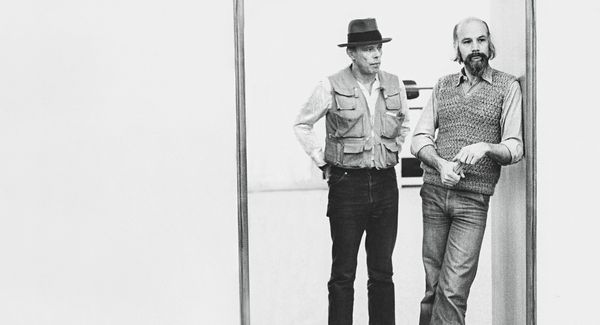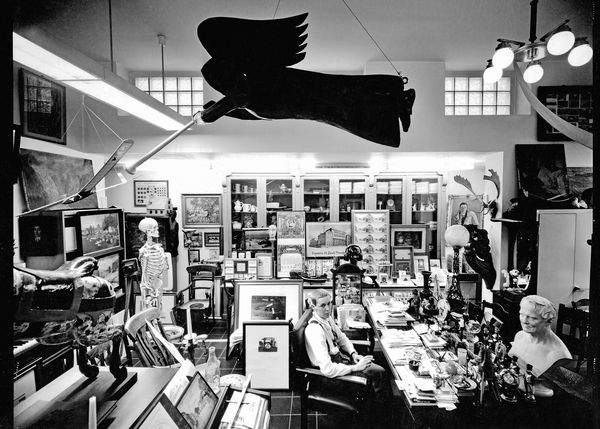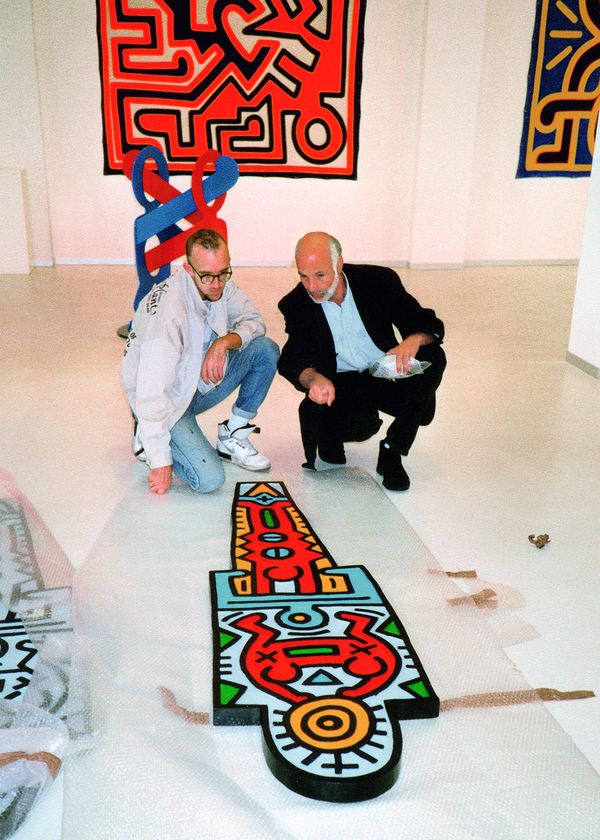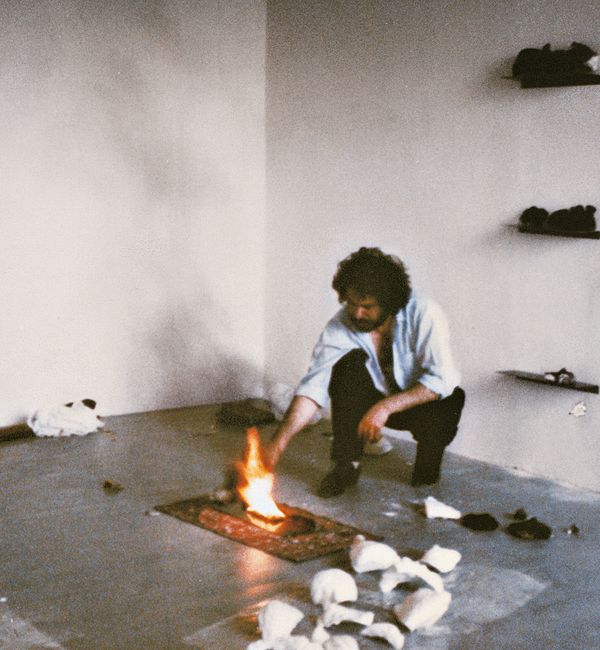Joseph Beuys with Joerg Schellmann installing Zeige Deine Wunde (Show Your Wound) at Lenbachhaus, Munich, 1980 © DACS 2019
Striving for an art that is affordable to all, Jörg Schellmann became a renowned gallerist and publisher of limited edition artworks through Schellmann Art. His mission brought him into proximity with some of the most famous and successful artists of his time, including Keith Haring, Joseph Beuys, and Donald Judd, all of whom he enthusiastically encouraged to explore the creative possibilities of edition-making. In anticipation of Fifty Are Better Than One, Schellmann looks back at some of his most formative experiences working with these iconic artists.
On Joseph Beuys:
"In the late 1960’s, during Pop Art times, when the art world and I were fascinated by the new images coming from London and New York, there was a German artist both gallerists and collectors of acquired taste were talking about: a man who made sensitive drawings of deer and mountains and used basic materials like felt, fat and copper in his sculptures and objects. Just a complete contrast to the striking world of industrial signs and consumer products the Pop artists were celebrating. In 1970, my gallery partner at the time, Bernd Klüser, and I decided to go and visit this artist, Joseph Beuys, to suggest to him a show of about thirty multiples that he had realised by that time. This visit to an impressive personality ended with plans for several projects at once – a show of his multiples including the first Catalogue Raisonné of these works and the first edition that we made with Beuys. For the next meeting, we had designed two exhibition posters for him to choose from. Beuys suggested printing both: two posters for a small show of some thirty multiples in a little backyard gallery. This was the enthusiastic beginning of a long and seminal collaboration, which had a deep impact on both my further work as a publisher and on my personal life."
Jörg Schellmann, 2019
Hanne Darboven in her studio, Hamburg-Harburg © Hanne Darboven © Schellmann Art
On Hanne Darboven:
"Hanne’s work is located somewhere between books and drawings. One day, the book publisher Lothar Schirmer called me up and said that Hanne was interested in making some portfolios out of a number of her thousands of sheets of paper that she had carefully written on and illustrated with photos. My first visit to her studio in Hamburg – the traditional home of the Darboven Coffee producing family – was very weird. Hanne first gave me instructions for where to place my briefcase and what the schedule of my visit would be. A totally organized life and work! She gave me a tour through her house that was filled to the top with books and objects referring to all sorts of cultural subjects: from art to kitsch, from science to kitchen. Eventually, she opened heavy folios filled with thousands of lines of accurate handwriting. Although the lines – often written in pseudo script – kept repeating themselves with hardly noticeable variations, she was turning the pages very slowly to give me time to read every line. When the day was over, I sensed I had become part of her realm of script and objects, and it felt absolutely natural to me reading pages of “waves” that described and archived history. The minimal beauty of her systems and her ideas of order had infected me."
Jörg Schellmann, 2019
Keith Haring and Joerg Schellmann looking at a prototype for Totem, at Hans Meyer Gallery, Dusseldorf, 1987 © The Keith Haring Foundation, 2019 © Schellmann Art
On Keith Haring:
"In 1985, Keith had made a series of drawings for a text by Brion Gysin and wanted to turn this material into a book. However, he did not succeed in finding a publisher due to the heavy sexual imagery in his drawings. So he asked me if I could recommend a publisher in Germany. When I looked at the drawings, I could see the problem, but spontaneously offered to publish the book myself if Keith were to do an object in an edition for me - assuming that the book would hardly pay for its printing costs. Keith was very pleased and promised to come up with something – which indeed he did: he made the Dog multiple. As expected, the book sold slowly over the years, whereas the Dog garnered great popularity over the 30 years of its existence."
Jörg Schellmann, 2019
Installation view of the 15 x 105 x 15 exhibition held at the Judd Foundation, 101 Spring Street, New York, 26 April – 28 July 2018 © Judd Foundation / ARS, NY and DACS, London 2019 © Schellmann Art
On Donald Judd:
"After becoming a little frustrated that Don had not responded to some projects that I had suggested to him in 1989 and 1990, I changed tactics and asked him if there was anything else he would be interested in doing. Unexpectedly, his face turned friendly and he said: “There is something, an object that is simple to make, all made out of one piece with no welding or screwing but pretty expensive to do as it requires the production of an industrial tool”. In order not to miss out on an opportunity, I declared myself ready to bear the costs. Don explained that the factory in Switzerland needed to produce a minimum 200 metres of the unique aluminium profile that Don had in mind. He made a little sketch of the design on a restaurant receipt and I was immediately thrilled by the concept. The portcullis-like cross-sectional profile of this multiple does not appear in any other edition by Don, and is realised in twelve different anodized colours, each in an edition of twelve. However, Don did reserve the right to use a few of the anodized pieces, several metres long each, for separate one-off works. When it came to the actual production at Alu Menziken, I asked Don to determine the colours. Don said: “that’s a business aspect of the pieces, so you choose the colours.” I was thrilled to do so although the colour chart proved to be pretty limited and mainly contained the spectrum of industrial anodizing tones. When the pieces were released in 1991, sales were pretty poor so I asked Don if we could lower the price a bit or offer better discounts to dealers. He rejected the suggestion, so it took a few years until suddenly there was a great demand and prices went up. Looking back on the pieces today, I feel it is one of the most significant editions I have produced within my 50 years of publishing."
Jörg Schellmann, 2019
Jannis Kounellis working at Schellmann & Kluser Gallery, Munich, 1982 © Jannis Kounellis © Schellmann Art
On Jannis Kounellis:
"In 1985 my gallery partner, Bernd Klüser, and I had arranged an exhibition with Jannis at our gallery. While installing the show, he used – to both our surprise and against our security concerns – open fire that he lit on the wooden gallery floor to apply smoke to several objects and to areas on the walls. After the show had shaped up, I asked him if he could do an edition for me. Instead of answering though, he started walking up and down the space looking left and right, at the floor and at the ceiling. Finally, he opened one of our tall classicist windows and dismounted a 181 x 64 cm window sash. Although I told him the window was part of a protected landmark building, he started to treat the window glasses with fire. The resulting piece became the prototype for an edition of twenty-one windows with photo processed glasses. As in his work in general, Jannis had used poor basic and elementary material to create pieces that suggest remnants of history, fragments of lost culture and art, things of daily use – quotes from the past that Kounellis turned into contemporary signs."
Jörg Schellmann, 2019
Joerg Schellmann and Thomas Ruff in his studio, Dusseldorf, 2014 © Thomas Ruff © Schellmann Art
On Thomas Ruff:
"In 1986, I saw three small photos in a group show of a public space. The photos showed interiors of lower middle class German apartments taken in an emphatic documentary and minimal manner, with no whiff of arrogance, lending dignity to these generic bourgeois interiors. I decided to contact the artist behind these photos. Some months went by without communication until I saw Thomas Ruff’s large-scale portraits at the Kunstverein, Munich. Now it was clear, I had to see this artist. I met Thomas in his little studio compartment in a municipal industrial building that he was sharing with a number of other artists at the time, which he now owns. We started working on editions together and have now been doing so for 30 years; always with the understanding that Schellmann Art publishes a set of prints for each subject or theme the artist explores - a wonderful working relationship realising over 150 works since 1988."
Jörg Schellmann, 2019





